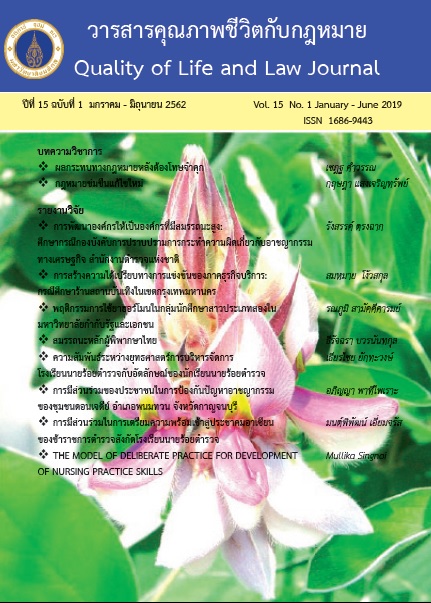The use of hormone therapy among trans-woman students in government and private university
Main Article Content
Abstract
This study aims at carrying out a study into the use of hormone therapy among trans-woman students, who study in bachelor degree (1st - 7th year students), in government and private universities in Prathum Thani province, and their perceptions towards the impacts of hormone therapy usage. The study is conducted on the basis of cross-sectional quantitative research method with aim to understand trans-woman student’s behaviours in using hormone therapy and their motives in using that. Through this research methodology, the study uses questionnaires to conduct a survey with 120 people. Moreover, the study also applies a qualitative research method of in-depth interviews with 16 people in order to understand their positive and negative perceptions towards the impacts of hormone therapy usage. Data analysis for this research is based on the methodology of descriptive statistics using SPSS program, and content analysis.
According to the results from the study, it shows that the most common type of hormone therapy among trans-women students is by taking, followed by injecting and implanting, respectively. When analyzed in terms of their behaviours in buying hormones and the sources where hormones are being sold, the study reflects that trans-woman students are most likely to buy hormones from sellers, who are transgenders. Drug stores are the most popular place, where they go to buy hormones from. Their primary motivations for using hormone therapy is that they want to have their outer appearance to look more like women e.g. having more beautiful skin, bigger breast, more tightened pore size, and preparing their body for sex reassignment surgery in the future. In this regard, trans-woman students from government and private universities have similar perceptions. However, their behaviors in using hormone therapy are quite different. The study also shows that trans-woman students from government and private universities have the same positive and negative perceptions towards physical and mental impacts of hormone usage. But their opinions in the sense of mental impacts and economic status are observed to be different.
As for recommendations from this study, the researcher opines that it is important for drug stores to play a more significant role in providing comprehensive knowledge including benefits and impacts from using hormone medicines for trans women. Furthermore, there is necessary to take into account trans women’s behaviours in using hormone therapy upon developing a comprehensive healthcare system for them.
Article Details
- บทความหรือข้อคิดเห็นใดๆ ในวารสารคุณภาพชีวิตกับกฎหมายเป็
- กองบรรณาธิการไม่สงวนสิทธิ์
References
ปิยลักษณ์ โพธิวรรณ์. (2557). คนข้ามเพศ : ตัวตน วัฒนธรรมย่อย และพื้นที่ทางสังคม. สืบค้นเมื่อ 8 เมษายน 2561. เข้าถึงได้จาก: http://www.damrong-journal.su.ac.th/upload/pdf/56_5.pdf
นรุตม์ ศุภวรรธนะกุล. (2561). การข้ามเพศ: การเดินทางจากเพศที่สามสู่โลกชายจริงหญิงแท้. สืบค้นเมื่อ 8 เมษายน 2561. เข้าถึงได้จาก: https://prachatai.com/journal/2018/01/74868
นันทชา สำโรง. (2552). ทัศนคติของผู้ชมที่มีต่อภาพลักษณ์ของกะเทยที่ปรากฏในสื่อโทรทัศน์ศึกษาเฉพาะนักศึกษาปริญญาตรีในเขตกรุงเทพมหานคร. วิทยานิพนธ์วารสารศาสตร์มหาบัณฑิต สาขาสื่อสารมวลชน คณะวารสารศาสตร์และสื่อสารมวลชน มหาวิทยาลัยธรรมศาสตร์, ปทุมธานี.
ภาสินี พลับบุรีและทีมข่าว New Media PPTV. (2558). เปิด “แทนเจอรีน” คลินิกคนข้ามเพศแห่งแรกในประเทศไทย!. สืบค้นเมื่อ 4 เมษายน 2561. เข้าถึงได้จาก:https://www.pptvhd36.com/news/99/19282.
ไพศาล ลิขิตปรีชากุล. (ไม่ปรากฎปีที่พิมพ์). การจัดภาวะข้ามเพศให้เป็น “ความผิดปกติด้านอัตลักษณ์ทางเพศ”คุ้มค่าต่อการทำให้เกิดความรังเกียจต่อคนข้ามเพศหรือไม่?. สืบค้นเมื่อ 24 เมษายน 2561.เข้าถึงได้จาก: http://www.sapaan.org/article/75.htm.
ยุวดี. (2557). ความหมายของทรานส์แมน ผู้ชายข้ามเพศ. สืบค้นเมื่อ 24 เมษายน 2561.เข้าถึงได้จาก: https://teen.mthai.com/tomdy/70758.html.
ธนวัฒน์ จัตตุวัฒนาและสืบสกุล ปลอดโปร่ง. (2549). การศึกษาระบาดวิทยาของการใช้ยาฮอร์โมนเพศในเพศชาย. สืบค้นเมื่อ23 กุมภาพันธ์2561 เข้าถึงได้จาก: http://www.pharmacy.mahidol..ac.th/newspdf/specialproject/2549-42.pdf.
บุษกร สุริยสาร. (2557). อัตลักษณ์และวิถีทางเพศในประเทศไทย. องค์การแรงงานระหว่างประเทศ ประจำประเทศไทย กัมพูชา และ สาธารณรัฐประชาธิปไตยประชาชนลาว; โครงการส่งเสริมสิทธิ ความหลากหลาย และความเท่าเทียมในโลกของ การทำงาน (PRIDE). – กรุงเทพฯ: องค์การแรงงานระหว่างประเทศ
นฤพนธ์ ด้วงวิเศษ. (2553). ขบวนการเคลื่อนไหวของเกย์ในสังคมไทยภาคปฏิบัติการและกระบวนทัศน์. วิทยานิพนธ์สังคมสงเคราะห์ศาสตร์ดุษฎีบัณฑิต สาขาวิชาการบริหารสังคม คณะสังคมสงเคราะห์ศาสตร์มหาวิทยาลัยธรรมศาสตร์. ปทุมธานี.
John Wiley.Health Policy Project, Asia Pacific Transgender Network, United Nations Development Programme. (2015). แนวทางต้นแบบการให้บริการ สุขภาพที่ครอบคลุมแก่บุคคลข้ามเพศและชุมชนข้ามเพศในภูมิภาคเอเชียและแปซิฟิก (Blueprint for the Provision of Comprehensive Care for Trans People and Trans Communities). Washington, DC: Futures Group, Health Policy Project.
MGR Online. (2548). เส้นทางสู่มงกุฎของ ‘นางงามสาวประเภทสอง’. สืบค้นเมื่อ 8 เมษายน 2561.เข้าถึงได้จาก: http://www.manager.co.th/Daily/ViewNews.aspx?NewsID=948000006783.


